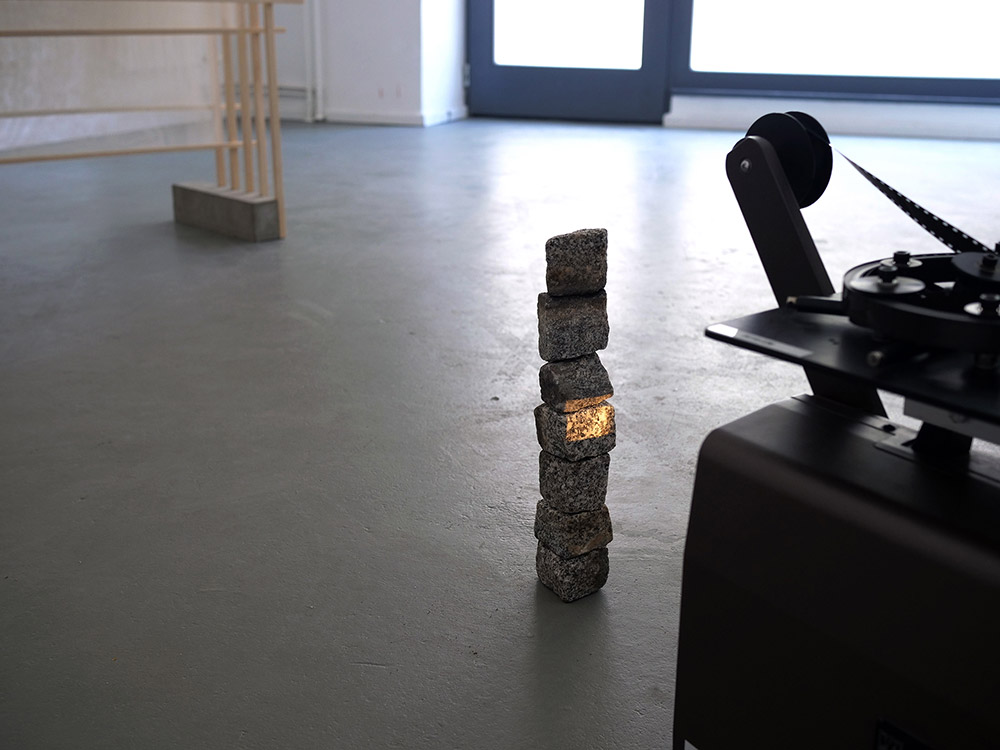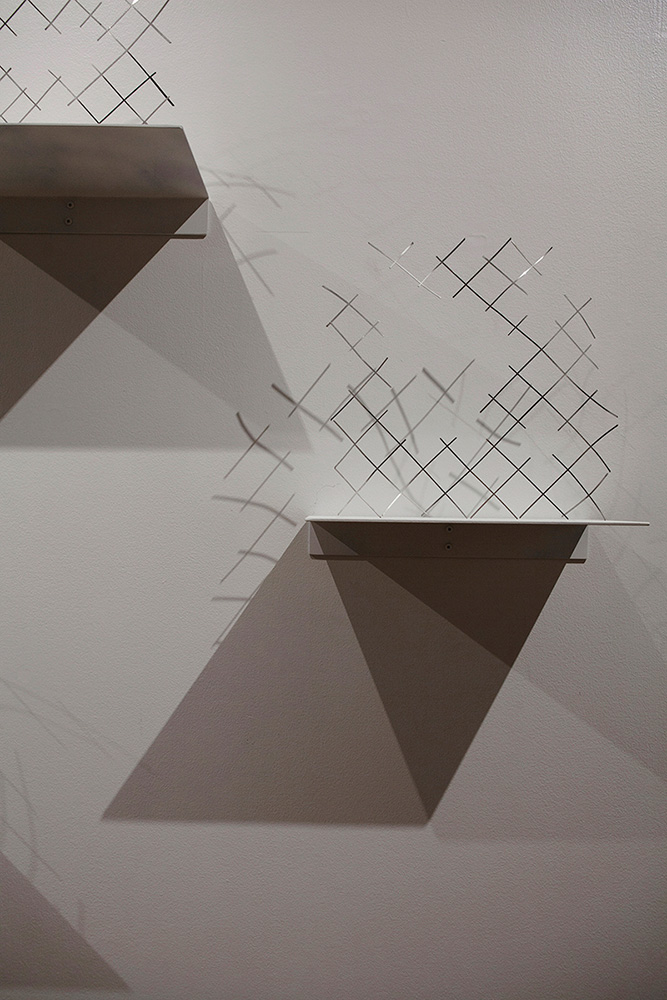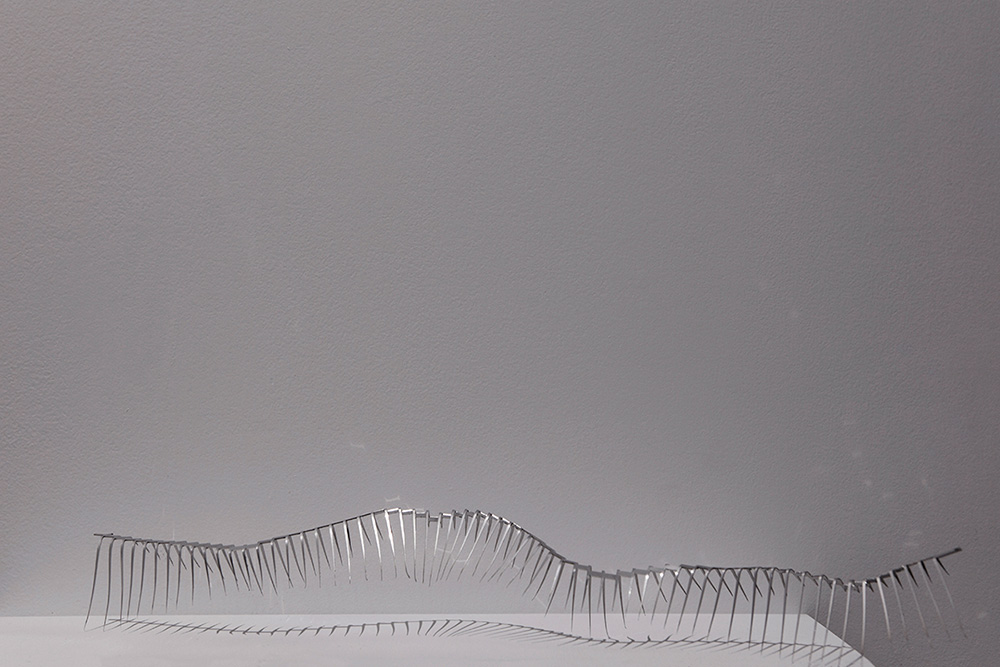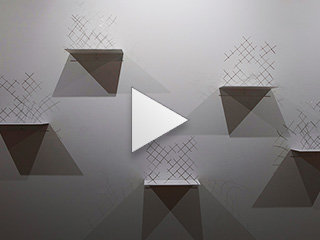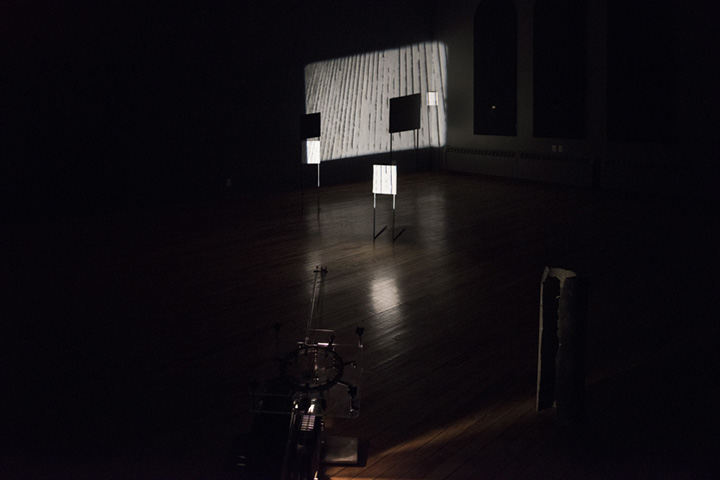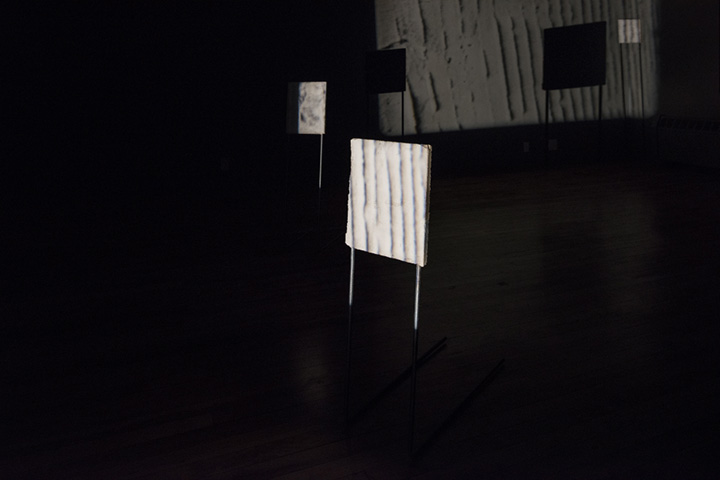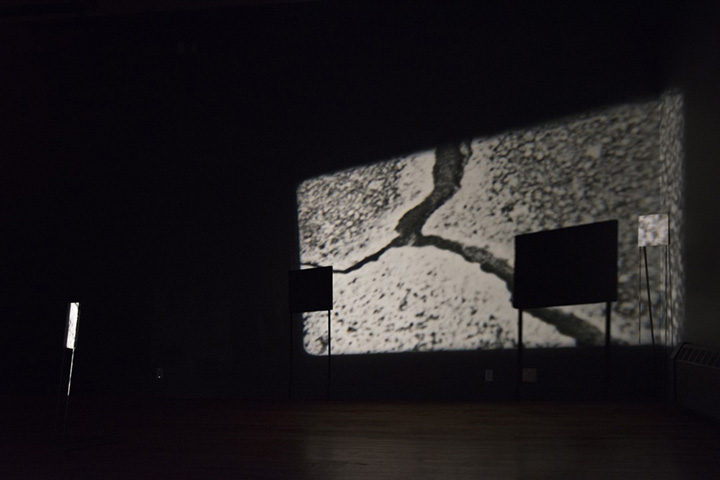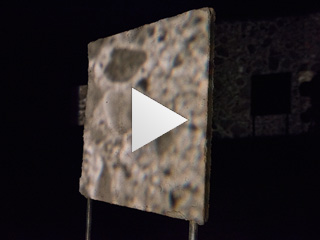
genizah
Solomon Nagler & Angela Henderson
Das Institut für Alles Mögliche
Wedding, Berlin / July, 2017
Exploring the impermanence and anarchitectural forms of non-archives, this work documents the light and deteriorating materials stored in the Chevra Nosim genizah; a book graveyard that is hidden in the only surviving synagogue in Lublin, Poland. In this space, ancient books are laid to decay, embraced by contemporaneous time and circumstance. Treated like human bodies, as they fade to dust, the sacred is thought to be released from its corporeal form.
Angela Henderson and Solomon Nagler present a triptych of works that emerge as an anti-monument. Duration is both implicitly presented in the form of a 16mm film, and implied through the subtle stratum of natural light expressed within the work’s sculptural elements. Layers of fabric, grounded in cement castings, at once erase and abstract, while embracing minimalist principles of a direct material presence of the work. A looping projector screens abstract light textures, captured through a series of cameraless experiments, where celluloid material was embedded in the non-archive in Lublin. The light escaping into the space through its porous walls and emanating from the decaying material itself creates a structuralist index of the inevitable transience of form. The projection is embedded in a precarious tower of seven found stones, a reference to memory and mourning, expressing the numerological significance of 7/8. The former representing corporal world and the later ephemeral presence. A leaning, casted cement sculpture is a memorial that has undergone erasure. Tension is expressed through a gestural wrapping of string around 18 measures embedded in the work. As a whole the genizah is a composite form that explores the fragility of memory and the subtle, fleeting presence of light movements.
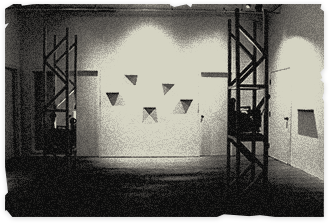
genizah hulls
Solomon Nagler & Angela Henderson
Poolside Gallery / Video Pool Media Arts Centre / WPG
This exhibition is a continuation of a collaborative project with Angela Henderson that explores the porous architecture of the genizah; a non-archive where sacred printed matter deteriorates without intervention. Laser cut steel sculptures, 16mm projections and speculative wood structures draw out the tension between digital processes and hand-formed objects. This assemblage suggests an archive of ephemera; a tension between stasis and flux; illumination and the ineffable.

Afterlife
Solomon Nagler & Owen Armour
Installation, Performance / Denmark, Canada / 2015
Halifax Independent Filmmakers Festival
Concrete, metal, 16mm loop, modified 16mm optical sound reader, variable dimensions.
Afterlife is a meeting of sculpture and alternative motion picture processes in which concrete forms are traced, mirrored and illuminated by celluloid loops. A surface is projected back onto itself, the celluloid is intercepted and transformed creating an architecture of disappearance–a body that lives and changes in time; duration, decay and scrawled text, the stationary and abstract. Hollis Frampton notes in The Withering Away of the state of Art that the analog image is unable to regress into its material of origin (celluloid). It is limited to the “known and the unknown, the seen and the unseen, what is present and possible to consciousness and what is absolutely elsewhere...and unimaginable”.
Our work uses the inertial force of analog technologies as a means of creating experimental architectures and sculptural interventions. Celluloid can stop. In contrast, digital has no end. The analogue image will always reference the trace of what was filmed--an actual event, an imprint of time and space.
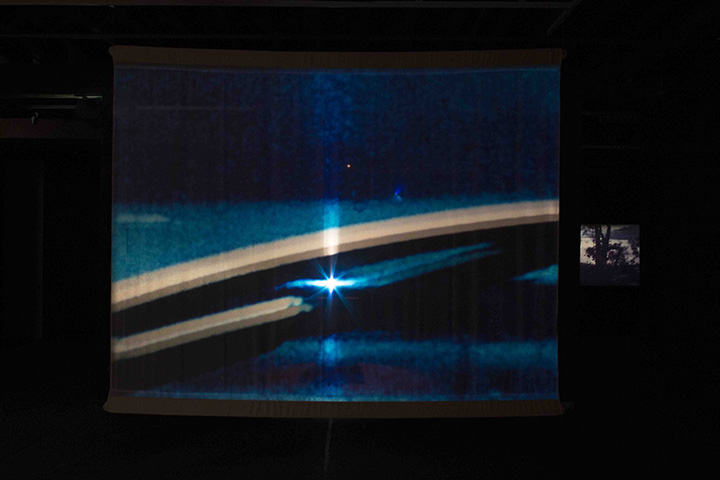

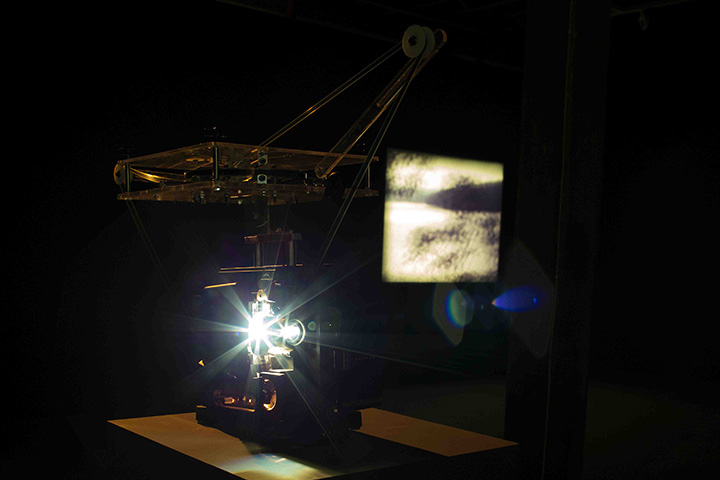
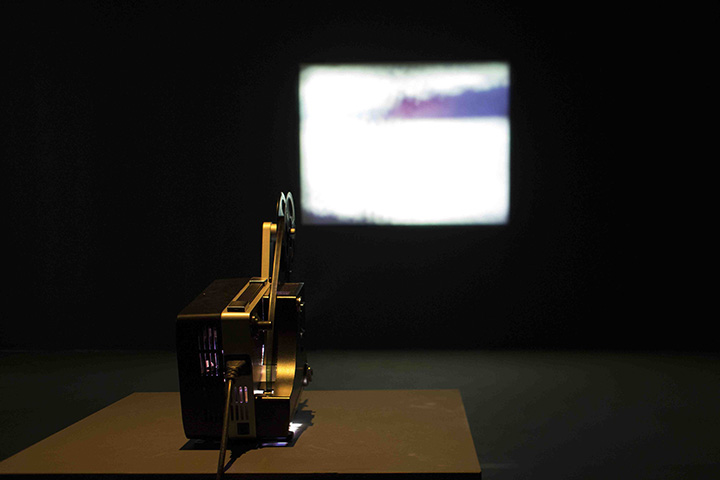
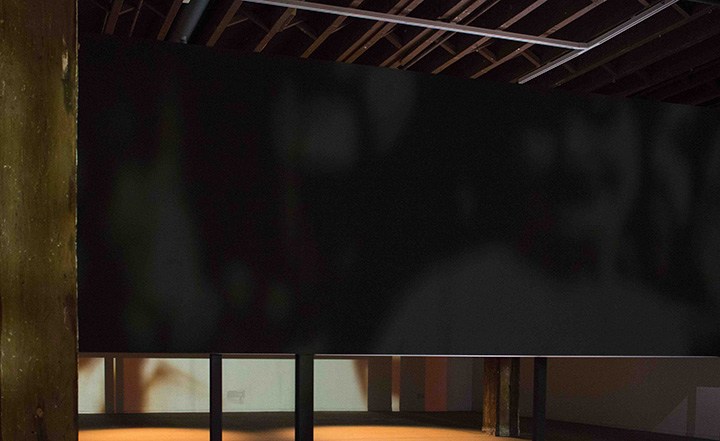

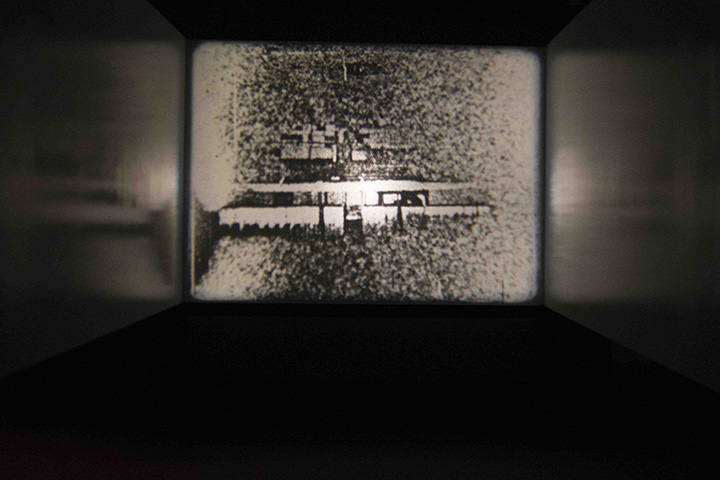


Photo and Video Documentation
by Louise M Cooper
Artspace.org.au
"Another Kind of Cinema"
Review by Mike Leggett, RealTime Arts, Issue 120.
Situated Cinema - Artspace
A project by Solomon Nagler & Alexendre Larose
Hand-Processed 16mm Ektachrome and High Contrast Positive Film Loops, 8mm Archival Kodachrome Loop, Dual 8mm Projector, 16mm Projectors and Loopers, Plywood Enclosure and Fabric Screen.
An engagement between architecture and experimental film, the project conceptualizes a new form of spectatorship through an intermingling of the experience of gallery and the relative intimacy of film. To do this, the Situated Cinema reinvented the cinema space as temporary, ephemeral, and rather than self-contained, contained within the gallery. Silent, 16mm and 8mm film loops were situated within the gallery, which was redesigned as contrary cinema spaces within a space. The silence of the films, in conjunction with the relative silence of the gallery, emphasizes and exposes the mechanics of film-based production and projection—revealing that which is so frequently and increasingly obscured, even fetishized.
"Situated Cinema is a commissioned collaborative project by the internationally respected Canadian film artists, Solomon Nagler and Alexandre Larose. Emphasizing and exposing the raw mechanics of film-based production and projection, this immersive installation reveals elements of the filmic process that viewers rarely have the opportunity to experience.Artspace has been reconfigured through the introduction of the site-specific architectural structure in the far-left gallery space. Crawl under the walls and enter this viewing space to experience a 16mm film loop that documents the crumbling walls of a Vaudeville era theatre in Sackville, New Brunswick. Shot exclusively with the natural light that filtered through the open doors and cracked windows of this ruined theatre-cum-cinema space, the artists incorporated open-shutter techniques and experimented with the alchemical properties of the physical photographic film to create this visual document of light within the theatre, the trace of past performances and the layering of a once narrative space
To the far right of this structure two looped projections play repeatedly to re-imagine a deteriorating archive. The films have been transformed over time by basement projections and ad-hoc storage. The two projections marry original found footage film-stock that documents daily family life and 8mm Kodachrome (a very fragile and long obsolete material) that has been analyzed and reframed. The result is a blistering colour flux of deteriorating film material; a celebration of amateur camera gestures, faulty framing, and in-camera edits; a reclamation of the original images and a resetting of their decay.
Through Situated Cinema, Nagler and Larose intentionally displace our preconceived notions of traditional models for viewing cinema. Intermingling the gallery experience and the materiality of film, these 16mm and 8mm projectors play silently, whilst light emanates throughout the darkened gallery environments. The galleries have been fully transformed into an unconventional and interactive cinema experience."
- Artspace Sydney


